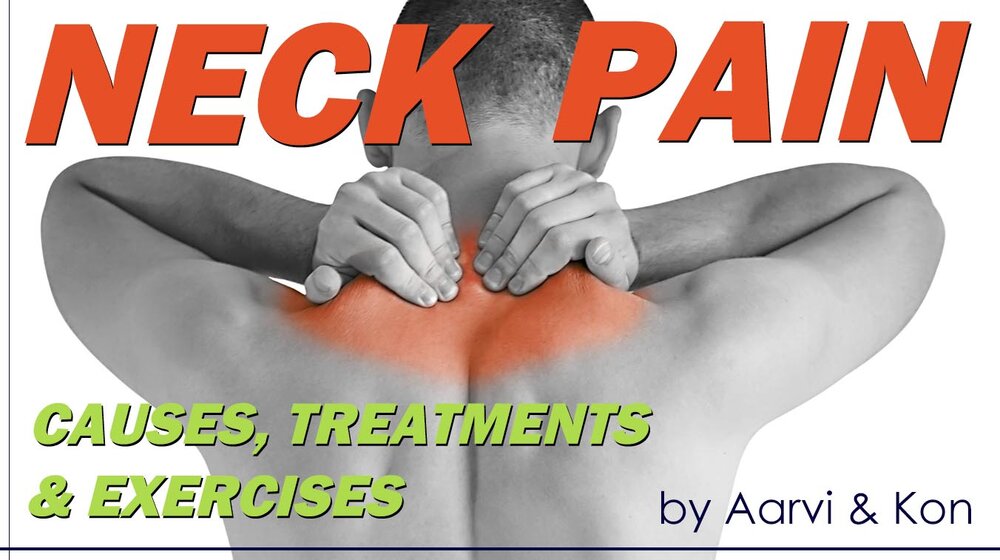Overload can result from –
- poor posture
- repetitive movements
- stress
- trauma
- degeneration due to ageing

Common Causes of neck pain include –
Muscle Spasm
Muscles are important for conveying stability and flexibility with neck movements.
When this happens, our muscles may experience areas of localised spasm which may be felt as knots, that impede muscle function and stress surrounding structures resulting in pain and stiffness during movement.
Excessive restriction and pain in our upper neck region may also produce headaches.
Degeneration
This is part of the natural wear and tear and ageing process that affects our discs and vertebrae, resulting in what is commonly known as osteoarthritis.
Gradual degeneration of our vertebrae leads to the production of bony outgrowths called osteophytes which is the body’s way of repairing itself.
However excessive bony development can impede proper movement of our joints or even put pressure on the nerves around the neck resulting in stiffness and pain.
Trauma
Any external force that causes a sudden high impact movement of the as in a whiplash injury resulting from a car crash or impact during sport can cause excessive stretching or damage to our ligaments, muscles and discs.
These structures normally provide stability and support against excessive force, but when overridden serious damage to these structures may occur, especially our discs that can put pressure on surrounding nerves resulting in acute pain.
Can Neck Pain Be A Sign Of Something Serious?
Neck pain may be a sign of serious injury in any of the following –
Symptoms Worsen
Neck pain becomes progressively worse when the intensity, duration or the area of pain increases and starts spreading to areas beyond the original source of pain, leading to progressively worsening movement with a corresponding elevation in pain levels.
Headaches
When neck pain causes restriction and pain that eventually results in headaches manifesting, on either side of the head and even spreading around the eye region.
Upper Limb Pain
Involves any pain or altered sensation (pins & needles or numbness) being produced in the upper limb especially when one’s neck pain is aggravated. A direct association between neck pain and upper limb pain is a strong indicator that the nerves in your neck may be affected.

When Should I Be Concerned About Neck Pain?
One should seek medical attention immediately if any of the symptoms mentioned above manifest and result in excessive pain and stiffness that disrupts one’s normal ability to engage in functional everyday activity.
Of importance is the manifestation of pain or altered sensation in either upper limb, especially if it is accompanied by a loss in upper limb strength, which may be noted in everyday life in tasks such as dropping objects or having difficulty in gripping and holding items.
How Can I Relieve My Neck Pain?
There are a number of ways to relieve your neck pain. We are going to discuss some simple things you can do right now that can make a big difference.
There are a number of ways to relieve your neck pain. We are going to discuss some simple things you can do right now that can make a big difference.
- Adding in more movement throughout the day rather than staying in one fixed position can assist significantly in reducing neck pain.
- Improving stress levels plays a big part in relieving neck pain. Stress has a physical effect on the muscles in your neck because it leads to the muscles in your neck becoming As you tense up, the tightness in your neck muscles contributes to neck pain.
- Exercise is a crucial part to relieving any kind of musculoskeletal pain especially neck pain. Doing exercise can help reduce pain, increase mobility, and strengthen the neck and postural musculature. This will allow the neck and shoulders to be able to tolerate more load and can help loosen the muscles and increase range of motion due to increased blood flow and decrease some muscles to overwork.
- Improving posture is a crucial part of decreasing any kind of neck pain because the stress on the neck is minimised when you have good posture as the head’s weight is naturally balanced on the spine. A good posture is commonly considered when the ears are positioned directly above the shoulders with the chest open and shoulders back. (think about having a crown on the head and not letting that drop)
What is the best treatment for neck pain?
It would have to be strengthening the postural and scapula muscles so the neck and shoulders are able to hold the head up properly and overtime will improve posture. Neck pain usually occurs when certain muscles are working too hard and some areas are underworking. So strengthening the low working muscles can help and assist with taking the load of the bigger working muscles.
A great exercise to start with is Andrew Lock’s Shoulder big 3 exercise.
It is a great activator for all the postural muscles in the back. Complete all 3 exercises one after another
#1 – Prone Rear Fly or T
Repeat 25 times



After completing the 3rd exercise, I would encourage repeating them all again
Hope this blog post can give you an idea on how neck pain can arise and what are certain things to watch out for or include to prevent any further pain in the neck
The most important thing to do is to find the cause of the neck pain and that can only be completed if you have properly been assessed
Correcting poor postures and addressing stress can also be vital in fixing this very painful and persistent injury.
Special exercises prescribed by your Physio are often required to alleviate the pain and prevent a recurrence.
ProPhysio+ are trained and experienced in the treatment of shoulder pain and will work closely with yourself to overcome this painful area
#MakingHealthySimple
Written by Kon Eleftheria and Aarvi Sandhu

